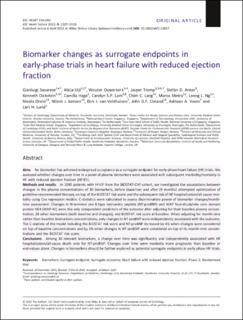| dc.contributor.author | Savarese, Gianluigi | |
| dc.contributor.author | Uijl, Alicia | |
| dc.contributor.author | Ouwerkerk, Wouter | |
| dc.contributor.author | Tromp, Jasper | |
| dc.contributor.author | Anker, Stefan D. | |
| dc.contributor.author | Dickstein, Kenneth | |
| dc.contributor.author | Hage, Camilla | |
| dc.contributor.author | Lam, Carolyn S.P. | |
| dc.contributor.author | Lang, Chim C. | |
| dc.contributor.author | Metra, Marco | |
| dc.contributor.author | Ng, Leong L. | |
| dc.contributor.author | Orsini, Nicola | |
| dc.contributor.author | Samani, Nilesh J. | |
| dc.contributor.author | van Veldhuisen, Dirk J. | |
| dc.contributor.author | Cleland, John G.F. | |
| dc.contributor.author | Voors, Adriaan A. | |
| dc.contributor.author | Lund, Lars H. | |
| dc.date.accessioned | 2022-10-10T13:43:14Z | |
| dc.date.available | 2022-10-10T13:43:14Z | |
| dc.date.created | 2022-05-23T13:05:47Z | |
| dc.date.issued | 2022 | |
| dc.identifier.issn | 2055-5822 | |
| dc.identifier.uri | https://hdl.handle.net/11250/3025165 | |
| dc.description.abstract | Aims
No biomarker has achieved widespread acceptance as a surrogate endpoint for early-phase heart failure (HF) trials. We assessed whether changes over time in a panel of plasma biomarkers were associated with subsequent morbidity/mortality in HF with reduced ejection fraction (HFrEF).
Methods and results
In 1040 patients with HFrEF from the BIOSTAT-CHF cohort, we investigated the associations between changes in the plasma concentrations of 30 biomarkers, before (baseline) and after (9 months) attempted optimization of guideline-recommended therapy, on top of the BIOSTAT risk score and the subsequent risk of HF hospitalization/all-cause mortality using Cox regression models. C-statistics were calculated to assess discriminatory power of biomarker changes/month-nine assessment. Changes in N-terminal pro-B-type natriuretic peptide (NT-proBNP) and WAP four-disulphide core domain protein HE4 (WAP-4C) were the only independent predictors of the outcome after adjusting for their baseline plasma concentration, 28 other biomarkers (both baseline and changes), and BIOSTAT risk score at baseline. When adjusting for month-nine rather than baseline biomarkers concentrations, only changes in NT-proBNP were independently associated with the outcome. The C-statistic of the model including the BIOSTAT risk score and NT-proBNP increased by 4% when changes were considered on top of baseline concentrations and by 1% when changes in NT-proBNP were considered on top of its month-nine concentrations and the BIOSTAT risk score.
Conclusions
Among 30 relevant biomarkers, a change over time was significantly and independently associated with HF hospitalization/all-cause death only for NT-proBNP. Changes over time were modestly more prognostic than baseline or end-values alone. Changes in biomarkers should be further explored as potential surrogate endpoints in early phase HF trials. | en_US |
| dc.language.iso | eng | en_US |
| dc.publisher | Wiley | en_US |
| dc.rights | Navngivelse-Ikkekommersiell 4.0 Internasjonal | * |
| dc.rights.uri | http://creativecommons.org/licenses/by-nc/4.0/deed.no | * |
| dc.title | Biomarker changes as surrogate endpoints in early-phase trials in heart failure with reduced ejection fraction | en_US |
| dc.type | Journal article | en_US |
| dc.type | Peer reviewed | en_US |
| dc.description.version | publishedVersion | en_US |
| dc.rights.holder | Copyright 2022 The Author(s) | en_US |
| cristin.ispublished | true | |
| cristin.fulltext | original | |
| cristin.qualitycode | 1 | |
| dc.identifier.doi | 10.1002/ehf2.13917 | |
| dc.identifier.cristin | 2026522 | |
| dc.source.journal | ESC Heart Failure | en_US |
| dc.source.pagenumber | 2107-2118 | en_US |
| dc.identifier.citation | ESC Heart Failure. 2022, 9 (4), 2107-2118. | en_US |
| dc.source.volume | 9 | en_US |
| dc.source.issue | 4 | en_US |

